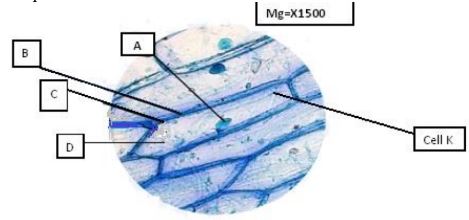BIOLOGY
PAPER 3
PRACTICAL
INSTRUCTIONS TO CANDIDATES
- Answer ALL the questions.
- You are required to spend the first 15 minutes of 1 3⁄4 hours allowed for this paper reading the whole paper carefully before commencing your work.
- Answers must be written in the spaces provided in the question paper.

Questions
- You are provided with the photomicrograph of an onion outer epidermis as seen under light microscope
- On the photograph, name parts labelled A, C, and D (3mark)
A
C
D - Explain how the part labelled B is adapted to its function (2marks)
- Calculate the actual size of the cell marked K, give your answer in micrometres (2marks)
- The differences between the cells in the photograph and those obtained from an animal epithelial cells (3marks)
Onion epidermal cells Animals epithelial cells - State the process that make the structures in the cell above appear more distinct (1mark)
- In microscopic procedure in 1 (d) above name what was used to achieve the process (1mark)
- On the photograph, name parts labelled A, C, and D (3mark)
- The photographs below represent specimen labeled A, B, C and D
- Name the type of placentation shown in specimen A and B (2 marks)
A.............................................................................................
B............................................................................................. - Identify the type of sections from which specimen C and D was obtained? (2 marks)
C.............................................................................................
D............................................................................................. - Classify the above specimen labeled D (1mark)
- You are provided with specimen labeled D1, D2, D3 and D4. Examine them
Draw and label specimen labeled D2 (3marks) - Giving a reason and state the agent of dispersal of the specimen (6marks)
Specimen Agent of dispersal Reason D1 D3 D4
- Name the type of placentation shown in specimen A and B (2 marks)
- You are provided with the following. Solution P, Q and Z.
-
- Put 2 cm3 of solution P into two test tubes labeled A and B. Add iodine solution drops into test tube A. Observe and record. (1 mark)
- To test tube B, add an equal amount of Benedict’s solution. Heat to boil. Record your observation. (1 mark)
- From the results in (a) (i) and (ii), identify solution P. (1 mark)
- Put 2cm3 of solution Z into a clean test tube labelled C. Add equal volume of Benedict’s solution. Heat to boil. (1 mark)
- Open the visking tubing provided, Pour solution P into the visking tubing and add 1cm3 of the solution R. Tie the visking tubing and ensure there is no leakage. Pour solution Z into a clean beaker till it is half full. Immerse visking tube in the solution Z in the beaker. Allow it to stand for 30 minutes. After 30 minutes, take 2cm3 of solution Z from the beaker into a clean test tube labelled D. Add equal amount of Benedict’s solution. Heat to boil. Record your observation. (1 mark)
- Account for the observation made in (v) above. (3 marks)
-
- Pour 2 cm3 of solution Q into a clean test tube. Observe and record the color of solution Q. (1 mark)
- Add 1 cm3 of sodium hydroxide into test tube containing solution Q. Record your observation. (1 mark)
- Explain the results observed in (b)(ii) above. (2 marks)
- State one factor that can affect the process demonstrated in 3a (v) above (1 mark)
-

Confidential
- Solution P- starch
- Solution Q- egg white
- Solution Z- water
- Solution R- Diastase
- Benedict’s solution
- Iodine solution
- Visking tubing - 8cm
- Thread
- 100ml beaker
- 5 test tubes
- 5 labels
- D1-Blackjack
- D2-Sonchus
- D3-Jacaranda
- D4-Mango
Download Biology Paper 3 Questions and Answers with Confidentials - Royal Exam Series Post Mock Trial Exams 2022.
Tap Here to Download for 50/-
Get on WhatsApp for 50/-
Why download?
- ✔ To read offline at any time.
- ✔ To Print at your convenience
- ✔ Share Easily with Friends / Students



